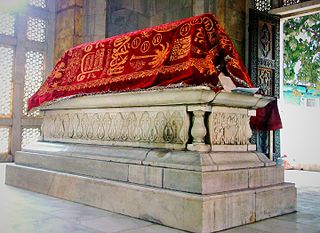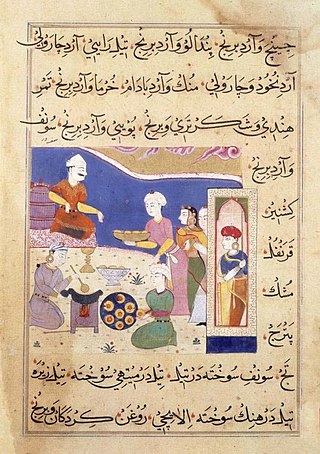Nasir al-Din, was originally a honorific title and is a masculine given name and surname of Arabic origin. There are many variant spellings in English due to transliteration including Nasruddin, and Nasiruddin. Notable people with the title or name include:

Shams ud-Din Iltutmish was the third of the Mamluk kings who ruled the former Ghurid territories in northern India. He was the first Muslim sovereign to rule from Delhi, and is thus considered the effective founder of the Delhi Sultanate.

Qutb ud-Din Aibak, was a general of the Ghurid emperor Muhammad Ghori. He was in charge of the Ghurid territories in northern India, and after Muhammad Ghori's assassination in 1206, he established the Delhi Sultanate (1206–1526), and started the Mamluk dynasty, which would rule the Sultanate until 1290.

The Mamluk dynasty was a dynasty which ruled Delhi Sultanate from 1206 to 1290. It was the first of five largely unrelated dynasties to rule the Delhi Sultanate until 1526. Before the establishment of the Mamluk dynasty, Qutb al-Din Aibak's tenure as a Ghurid dynasty administrator lasted from 1192 to 1206, a period during which he led forays into the Gangetic plain and established control over some of the new areas.
Sultan Mahmud Begada or Mahmud Shah I was the most prominent Sultan of the Gujarat Sultanate. Raised to the throne at young age, he successfully captured Pavagadh and Junagadh forts in battles which gave him his name Begada. He established Champaner as the capital.

Nasir ud din Mahmud Shah was the eighth sultan of the Mamluk Sultanate. The Tabaqat-i Nasiri, written by the court historian Minhaj-i-Siraj, is dedicated to him. His father-in-law Ghiyas ud din Balban handled the state affairs during his reign.
The Battle of Ghaghra, fought in 1529, was a great battle for the conquest of India by the Mughal Empire. It followed the first Battle of Panipat in 1526 and the Battle of Khanwa in 1527. The forces of Mughal Emperor Babur of the emerging Mughal Empire were joined by Indian allies in battle against the Eastern Afghan Confederates under Sultan Mahmud Lodi and Sultanate of Bengal under Sultan Nusrat Shah.

The Malwa Sultanate was a late medieval Islamic sultanate in the Malwa region, covering the present day Indian states of Madhya Pradesh and south-eastern Rajasthan from 1392 to 1562. It was founded by Dilawar Khan, who following Timur's invasion and the disintegration of the Delhi Sultanate, in 1401/2, made Malwa an independent realm. In 1562, the Sultanate was conquered by the Mughal empire from its last ruler, Baz Bahadur and it became a subah of the empire. The Sultanate was predominantly ruled by Afghan, and Turco-Afghan dynasties throughout its existence.

The Jaunpur Sultanate was a Muslim kingdom in northern India between 1394 and 1494, ruled by the Sharqi dynasty. It was founded in 1394 by Khwajah-i-Jahan Malik Sarwar, an eunuch slave and former wazir of Sultan Nasiruddin Muhammad Shah IV Tughluq, amidst the disintegration of the Delhi Sultanate's Tughlaq dynasty. Centred in Jaunpur, the Sultanate extended authority over Awadh and a large part of the Ganges-Yamuna Doab. It reached its greatest height under the rule of Sultan Ibrahim Shah, who also vastly contributed to the development of Islamic education in the Sultanate. In 1479, Sultan Hussain Khan was defeated by the forces of Afghan ruler Bahlul Lodi, Sultan of the Lodi dynasty of the Delhi Sultanate, which abruptly brought an end to independent Jaunpur and its reabsorption into the Delhi Sultanate.
The Farooqi dynasty was the ruling dynasty of the Khandesh Sultanate from its inception in 1382 till its annexation by the Mughal emperor Akbar in 1601. The founder of the dynasty, Malik Ahmad participated in a rebellion against the Bahmani ruler Muhmmad Shah I in his early years. When he was compelled to flee from Deccan, he established in Thalner on the Tapti River. After receiving the grant of the fiefdoms of Thalner and Karanda from Firuz Shah Tughluq in 1370, he conquered the region around Thalner, which later became known as Khandesh. By 1382, he started ruling independently.
Muhammad Shah I, born Tatar Khan, was a ruler of the Muzaffarid dynasty, who reigned over the Gujarat Sultanate briefly from 1403 to 1404 disposing his father Muzaffar Shah I.

The Mihrabanid dynasty was a Muslim dynasty that ruled Sistan from 1236 until the mid-16th century. It was the third indigenous Muslim dynasty of Sistan, having been preceded by the Saffarid and Nasrid dynasties.
Muhammad Zaman Mirza (1496–1539) was a Timurid prince, and general to Mughal Emperors Babur and Humayun. He claimed himself as the ruler of Gujarat in 1537 but did not gain actual control.

Nasir-ud-Din Mahmud Shah Tughluq, also known as Nasiruddin Mohammad Shah, was the last sultan of the Tughlaq dynasty to rule the Islamic Delhi Sultanate.

Ghiyath Shah, also known as Ghiyas-ud-Din Shah or Ghiyasuddin, was a Sultan of the Malwa Sultanate in the fifteenth century. The son of his predecessor Mahmud Shah I, he reigned from 1469 to 1500. A military leader before his accession, he was known during his reign for his religious devotion and cultural life. During his reign, the Nimatnama-i-Nasiruddin-Shahi was written and illustrated. His exiled son Nasir-ud-Din Shah revolted and took the throne in October 1500. Ghiyasuddin was found dead four months later and is believed to have been poisoned by his son and successor.

Muzaffar Shah I, born Zafar Khan, was the founder of the Muzaffarid dynasty in Medieval India, reigning over the Gujarat Sultanate from 1391 to 1403 and again from 1404 to 1411. The Kumbalgarh inscription says that Kshetra Singh defeated and captured Zafar Khan, King of Patan and the Khan remain in imprisonment with other Rajas.
Gujarat, a region in western India, fell under Delhi Sultanate following repeated expeditions under Alauddin Khalji around the end of the 13th century. He ended the rule of Vaghela dynasty under Karna II and established Muslim rule in Gujarat. Soon the Tughluq dynasty came to power in Delhi whose emperor carried out expeditions to quell rebellion in Gujarat and established their firm control over the region by the end of the century. Following Timur's invasion of Delhi, the Delhi Sultanate weakened considerably so that the last Tughluq governor Zafar Khan declared himself independent in 1407 and formally established the Gujarat Sultanate.
Nasiruddin Mahmud may refer to:

Nasir-ud-Din Mahmud Shah Sharqi or Mahmud Shah Sharqi was the 4th ruler of the Jaunpur Sultanate, reigned from 1440 to 1457. He succeeded his father Ibrahim Shah Sharqi as sultan and was known for his bravery and generosity. Mahmud suppressed internal rebellions and expanded his territories, defeating neighboring empires in the process. He consolidated a larger area through battles with strong neighboring empires, ultimately advancing the Jaunpur Sultanate.Haig, Wolseley (1928). The Cambridge History of India. Vol. III. Cambridge University Press. pp. 228–230, 252–253.Mahmud Shah Sharqi ruled over a vast area that included regions adjoining Bihar, Jharkhand, Uttar Pradesh, parts of Bengal, Nepal, Gondwana, Madhya Pradesh, and Odisha.

The Sack of Delhi was a battle between Timur, founder of the Timurid Empire and the Delhi Sultanate. It took place on 17 December 1398 and lasted for 3 days, and ended with the massacre of over 100,000 citizens as well as the Delhi army.












